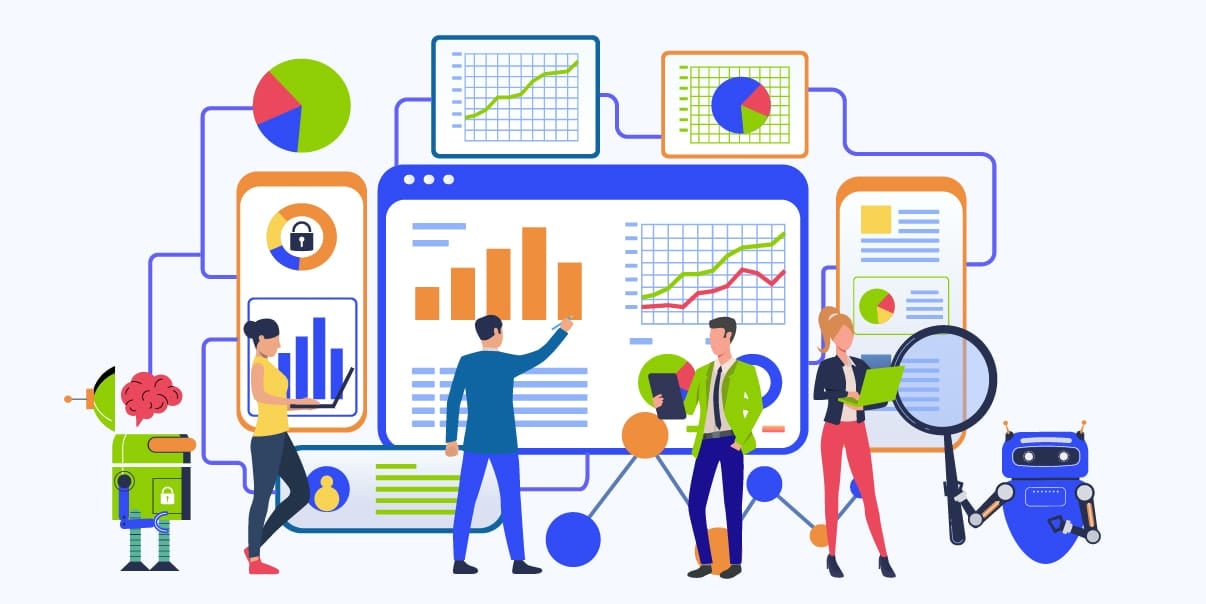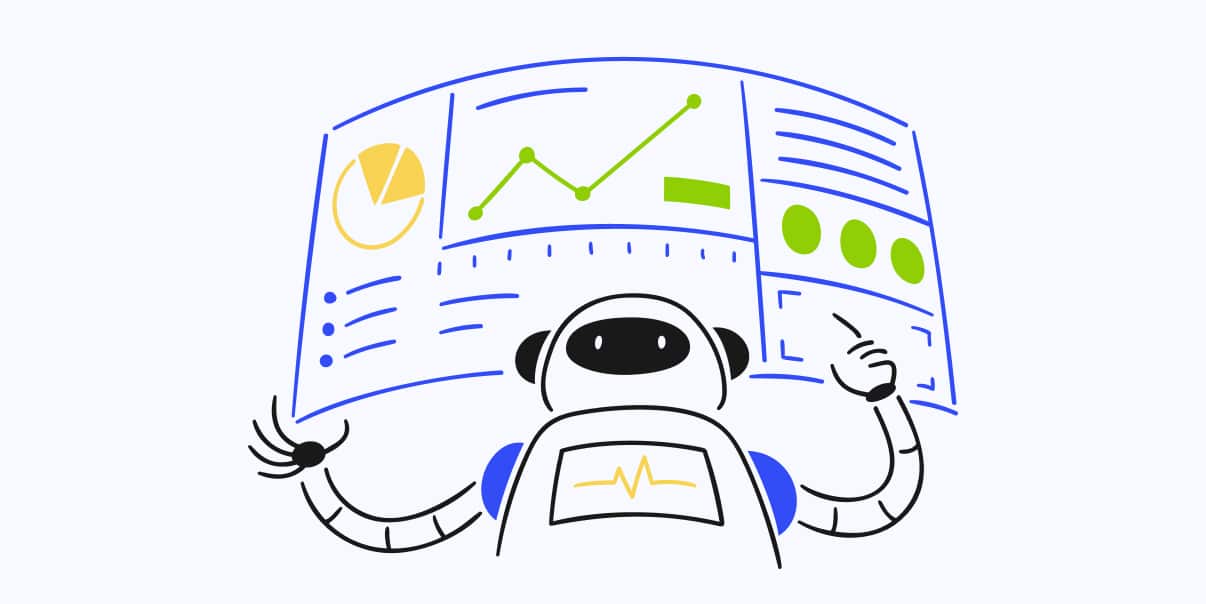Trends in Data Analytics: What to Watch Out For

Data analytics collects, organizes, and uses data from different sources to gain insights. It enables businesses to make informed decisions by providing valuable insight. For example, you can create new marketing strategies or improve customer service. Keeping up with trends in data analytics can help you use market info more effectively.
This article will discuss some exciting data analytics trends shaping today’s industry. We’ll look at the emerging technologies and digital transformation strategies you can use.
Increasing Adoption of Machine Learning
Machine learning (ML) is a form of data analytics that uses algorithms and statistics to identify patterns in large amounts of data. It can help you find relationships between different elements in the data. Also, it can efficiently handle complex tasks and provide valuable predictions.
In data analytics, you can use ML to automate data processing. It means you don’t have to input every piece of data manually. Instead, the system will analyze your data and give you insights.
Moreover, ML can provide insights faster, more accurately, and with less effort. It means you don’t have to spend time manually reviewing data or searching for patterns. The system will do the work for you.
Application of Machine Learning in Data Analytics
You can use ML for a wide range of data analytics. Here are some typical applications of ML in data analytics.
Predictive Analytics
ML can help you predict future trends. For example, you can use it to know customer demand or identify business risks. It can help you improve data visualization and business intelligence tools.
Natural Language Processing (NLP)
You can use ML to understand the meaning of natural language. It is vital for tasks such as customer support or search engines. With NLP, you can create better customer experiences. You can also ensure that the search engines index your content.
Image and Video Recognition
ML can detect objects in images or videos and differentiate between them. It is helpful for data analysis applications such as classifying and identifying photos.
Fraud Detection
You can use ML to detect fraudulent activity in your data. For example, it can identify suspicious behavior and alert you when something is wrong.
Data Fabric
Data fabric combines multiple information sources into a single platform. It allows you to access, manage, and share data more efficiently. Some companies are already using data fabric to improve their data interpretation.
Advantages of Using Machine Learning in Data Analytics
Using ML in data assessment has many advantages. It can help you save time and resources by automating data processing. Here are some other benefits of integrating machine learning into data analysis:
- Accuracy and Efficiency. ML algorithms can quickly process data to identify patterns. It means you don’t have to manually check every piece of information, which saves time and reduces errors.
- Automation of Repetitive Tasks. You don’t have to do tedious tasks like data entry or classification. Machine learning can automate them for you, saving time and resources.
- Better Customer Experience. AI can understand natural language, which is vital for search engines. This way, you can give customers more accurate and faster results.
Focus on Explainable AI
The increasing complexity of AI algorithms and models makes understanding their decision-making more challenging. Explainable Artificial Intelligence (XAI) is a new trend that lets you know how an AI algorithm works. It will help you avoid bias in the data and make better decisions.
Moreover, XAI can help you improve the accuracy of your information. You can use it to analyze your figures more efficiently and ensure the integrity of your collected data.
Importance of Transparency in AI
Transparency is critical for trustworthiness in AI and data management. It allows you to explain how an AI system works and why it makes certain decisions. Here are some of the reasons for the importance of transparency in AI:
- Building Trust
Explaining how an AI system works can help build customer and stakeholder trust. It will also help you earn their confidence and ensure accuracy.
- Compliance With Regulations
Transparency is essential to follow data privacy laws such as GDPR or CCPA. It helps you prove that your information is accurate and secure.
- Better Accuracy
Being transparent helps you to gain a better understanding of how the AI system works. It improves accuracy and efficiency, as you can identify potential issues before they arise. It also allows better decision-making and provides greater insight into statistical trends.
- Better Relationships
Transparency in AI helps build strong relationships with customers, partners, and other stakeholders. It offers trust and confidence in the system.
Also, it lets your users know that their data is secure and that you use them responsibly. It increases user engagement and loyalty, leading to improved business results.
Role of Explainable AI in Data Analytics
Here are two ways explainable AI can help you in data analytics:
- Model Validation. Explainable AI allows you to understand how an algorithm works and why it makes particular decisions. This way, you can confirm the AI model and ensure no errors or biases.
- Decision-Making. Explainable AI helps you get insights into the data, which you can use to make informed decisions. With transparency and explainability, you can trust the results of the AI system and make the right decisions for your business.
Examples of Explainable AI in Data Analytics
You can use several tools and techniques for explainable AI in data interpretation. Here are some of the popular ones:
- Local Interpretable Model-Agnostic Explanations (LIME). LIME is a tool that helps you understand how an AI model works and why it made certain decisions. It lets you interpret models quickly and identify potential biases in the data.
- SHapley Additive exPlanations (SHAP). SHAP is an algorithm that analyzes feature importance and helps you understand how a model works. It also allows you to uncover potential errors or biases in the data.
- Decision Trees. These are algorithms used for classification and regression tasks. They are easy to interpret, which makes them an ideal tool for explainable AI. They can help you gain insights into why a model made certain decisions.
- Partial Dependence Plots (PDPs). PDPs allow you to visualize how features affect the output of a model. It can help interpret models and uncover potential errors or biases in the data.
- Counterfactual Explanations. This AI technique uses counterfactual reasoning to explain your decisions. It analyzes how different features affect the output of a model. This way, you can understand why a model behaves in specific ways. They also allow you to uncover potential errors or biases in the data.
Integration of Big Data and Data Analytics
Big data and data analysis are two crucial aspects of data science. Big data refers to large data sets you can’t process with traditional methods. Data analysis involves using statistics and artificial intelligence to gain insights from data.
The future of big data and data assessment lies in integrating the two. By combining data from different sources and using advanced AI, you can gain insights that weren’t possible before. It will help you make better decisions for your business and give customers a better experience.
Advantages of Using Big Data in Data Analytics
Using more data in your market analysis can provide many advantages. Here are some of the popular ones:
- Better Decision-making
When you analyze more data, you can make better decisions. For example, you can analyze customer behavior and preferences using more data. It helps you make better decisions about what products to sell.
- Better Efficiency
More data can help us identify areas where we can be more efficient. For example, a transportation company can use more data to optimize its routes and save time and fuel.
- Personalization
More data can help you personalize products and services to meet your customers’ needs. For example, you can use more data to recommend products to customers. You can base this on their previous purchases and browsing history.
- Innovation
You can use more data to identify opportunities and create new products and services. You can identify emerging trends and develop new products to meet those needs.
- Competitive Advantage
Companies that use more data to their advantage can gain a competitive edge. You can create targeted marketing campaigns using more data to understand customer behavior. It can be more effective than your competitors’ campaigns.
Challenges of Integrating Big Data and Data Analytics
Integrating a large amount of data into analytics can be complicated due to some challenges. Here are some of the most common ones:
- Data Integration
Combining information from different sources requires a lot of work. It requires removing errors on your data set. You must also change your data format from “raw” to a valid form. These steps can be tedious and time-consuming.
- Data Quality
Data quality can lead to correct business insights or decisions. Information from different sources can also be incompatible, making data automation difficult. So, you must ensure that all information you gather is accurate and current before using it.
- Data Security
Data security is essential when combining data from different sources. But using data automation in the integration process can increase the risk of data breaches or leakage. So, you need to secure the cloud computing and accessibility of your data using solid protocols.
- Skills Gap
Data analysis requires specialized skills and knowledge. But, finding the right talent to fill these roles can be challenging. You may have to spend time and money to find the right one.
But if you want to hire data scientists, you can choose to outsource. This way, you can take advantage of data assessment faster and with fewer resources.
Examples of Big Data Analytics in Practice
You can use data analysis in different industries and sectors. Here are some notable examples:
- Amazon’s Recommendation System. Amazon uses historical data on its customer purchases and browsing patterns. Then, they make recommendations for other products according to these.
- Google’s Flu Trends Analysis. Google collects data from search queries and social media posts to identify flu trends. It helps them understand how the virus spreads and which places are affected. This way, they can create early warnings and take the necessary precautions.
- Walmart’s Supply Chain Optimization. Walmart uses information from customer purchases, weather data, and inventory levels. It helps them optimize their supply chain and create more orders when needed.
Democratization of Data Analytics
Data analytics has traditionally been the domain of a data scientist and data engineer. However, the democratization of data analysis is shifting this power from data scientists to business users. It allows non-technical professionals to understand data and use it for decision-making.
Also, data democratization is helping data-driven organizations. It allows them to unlock data insights quickly and make data-driven decisions faster. This way, you can stay ahead of the competition and create better products or services.
Advantages of Democratization of Data Analytics
Democratizing data analysis can provide many advantages for your business. Here are some of them:
- Increased Efficiency. Democratization allows you to access important information quickly. This way, you can use them for decision-making conveniently. Also, this step can help you save time and resources. You can also focus on other tasks.
- Better Data-Driven Decision Making. Democratization allows non-technical professionals to use data. This way, more people in your organization can make data-driven decisions.
- Better Collaboration. Democratization encourages collaboration between teams and departments. It helps you share and analyze data insights quickly, making better decisions.
- Cost Savings. By democratizing data interpretation, you don’t have to invest in data science or data engineering resources. This way, you can save money and use it on other projects.
Challenges of Democratization of Data Analytics
Democratizing data assessment can be complex due to some challenges. Here are some of the most common ones:
- Data Quality
Poor data quality can lead to wrong insights and decisions. You must ensure the accuracy and integrity of your information before analyzing data. It will also help you avoid data errors.
- Data Security
You must secure sensitive information when regulating data analytics. You need to encrypt and protect your data throughout the process. But it may be challenging to manage all information while sharing them across multiple users.
- Lack of Technical Expertise
Data democratization requires specialized skills and knowledge. But finding the right talent or resources can be difficult and expensive. So, you must prepare enough budget for the training and development costs.
- Resistance to Change
Your organization’s culture may resist data democratization due to a lack of understanding or technical skills. You need to create a data-driven culture that encourages collaboration and informed decision-making.
Increased Emphasis on Data Privacy and Security
Data privacy and security are becoming more critical in today’s digital world. It protects your personal information from unauthorized access.
Data security is essential because more people use technology to store and share information. For example, when you create an account online, you might have to give your name, address, and email. You keep this information in the company’s database. If someone hacks your database, they can steal your personal information.
Companies are putting more effort into protecting personal information to prevent this issue. They use encryption, like a secret code, to make it harder for hackers to access data. They might also use firewalls to keep other people from getting your info.
Also, governments are creating laws to protect personal information. For example, the European Union has General Data Protection Regulation (GDPR). It requires you to get people’s permission before using their personal information. Other countries have similar laws.
Importance of Security and Data Privacy in Data Analytics
Data privacy and security are essential for data assessment. Without proper protection, your data could be exposed to misuse or fraud. They can have severe consequences for your business, such as legal penalties or damaged customer trust.
Below are some of the reasons why data privacy and security are essential when interpreting data:
- Protecting Sensitive Data
Data privacy and security measures protect sensitive information from unauthorized access or misuse. This way, you can ensure accuracy and integrity for data sharing or data assessment.
- Maintaining Trust with Customers and Stakeholders
You can build trust with customers and stakeholders by taking privacy and security measures. It will help them feel secure and comfortable while using data analytics. Also, it will help you remain compliant with data regulations.
- Legal and Regulatory Compliance
Data privacy laws such as GDPR or CCPA need data owners to have data protection by design and default. By following data regulations, you can ensure legal and regulatory compliance.
- Business Continuity
Securing data prevents data breaches or misuse, which can seriously affect your business. By protecting data, you can maintain your business’s continuity and reputation.
Challenges of Ensuring Data Privacy and Security in Data Analytics
Data privacy and security are essential when using data analytics. Here are some challenges we face in keeping data private and secure:
- Keeping Data Safe From Hackers
Some people try to steal information from computer systems. They can access your data by breaking through your system. So, this makes it essential to have strong security measures to protect you against hacking.
- Accidental Data Loss
You can lose important data due to accidents like hard drive failures or power outages. So, you must back up your data and store it in different locations to prevent loss.
- Inaccuracy in Data
You must ensure the data is accurate to get good results from data analytics. But sometimes, you may accidentally enter incorrect data. Some other people may also intentionally manipulate them.
- Data Breaches
When you collect data, it often includes information about people. You must protect their privacy by not sharing their personal information with others. You should also not use them in a harmful way.
- Compliance with Regulations
Laws and regulations around data privacy are constantly changing. You follow the rules and regulations for your data analytics projects.
- The complexity of Data Storage and Sharing
Securing data storage requires measures such as encryption or pseudonymization. You must also have data access control to ensure only authorized personnel can access your data. This way, you can protect your company information from misuse or fraud.
Conclusion
In conclusion, data analytics has come a long way over the past few years and shows no signs of slowing down. It is vital to stay up-to-date with all the latest trends to stay ahead of the game and succeed.
Upcoming trends in data analytics include the increased use of artificial intelligence, machine learning, and big data processing techniques. Taking advantage of these trends can give insight into your business decisions and unlock new opportunities. If you need help with data analytics for your business, BIT Studios can help. Our data experts have extensive experience in analytics and edge computing. Contact us today to learn how our data analytics solutions can help.
We’re BIT Studios!
At BIT Studios we specialize in designing, building, shipping, and scaling beautiful, usable products with blazing-fast efficiency



